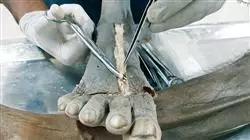University certificate
Scientific endorser

The world's largest faculty of medicine”
Introduction to the Program
Knowing how to analyze human behavior from a medical and psychological point of view is essential to solving legal situations that require the intervention of an expert"

The participation of forensic physicians in judicial processes is a constant, since the courts demand professionals from different areas who are able to determine, objectively and through reliable evidence, what may have occurred in a specific event, as well as the psychological conditions of those involved in the act. For this reason, there is a great demand for health professionals interested in taking programs on forensic medicine and forensic psychology, with which they can acquire the necessary skills to successfully manage an absolutely transcendental area at a legal level.
With this in mind, TECH has decided to design this Legal Medicine and Forensic Psychology, providing students with the most complete and up-to-date information on the main techniques and tools that they will be able to apply to their daily work. Accordingly, the program includes the basic and essential principles for the study of forensic thanatology, forensic pathology, forensic sexology, forensic toxicology, forensic psychiatry, damage assessment, anthropology and criminalistics, but also equally relevant aspects such as psychodiagnosis, expertise, mediation or coaching, among others.
In this way, physicians will acquire the ability to master the necessary psychodiagnostic tests at all times, and the subsequent elevation to a report, along with the skills to defend the conclusions obtained in court. At the same time, they are offered the possibility of learning to assess not only bodily injury, but also to quantify negligence, assess disability and determine disabilities.
This program is totally different from others that can be found on the market, since it places experience as the foundation of theory, providing a comprehensive understanding in order to practice with confidence. And transferring all this knowledge to the planning and subsequent implementation of professional work. Therefore, students will rely on theoretical resources to improve their knowledge, but they will also have a multitude of practical cases that will be essential to the learning of the theoretical part, so that they will study in a contextual way, as if they were facing real situations.
Additionally, one of the main advantages of this program is that they will study it 100% online, without the need for transfers or specific schedules, so that the students themselves can self-manage their studies, planning their schedules and pace of learning, which will be very useful in order to be able to combine it with the rest of their daily obligations.
Specialize in Legal Medicine and Forensic Psychology and utilize your knowledge to make useful reports to help solve conflicting cases"
This Advanced master’s degree in Legal Medicine and Forensic Psychology contains the most comprehensive and up-to-date academic course on the university scene. The most important features of the program include:
- Practical cases presented by experts in Forensic and Legal Medicine
- The graphic, schematic, and eminently practical contents with which they are created, provide scientific and practical information on the disciplines that are essential for professional practice
- Practical exercises where the self-assessment process can be carried out to improve learning
- Special emphasis on innovative methodologies in forensic medicine and forensic psychology
- Theoretical lessons, questions to the expert, debate forums on controversial topics, and individual reflection assignments
- Content that is accessible from any fixed or portable device with an Internet connection
TECH provides you with a multitude of theoretical and practical resources and the latest educational methodology on the market"
Its teaching staff includes professionals from the field of medicine, who bring to this program the experience of their work, as well as renowned specialists from leading societies and prestigious universities.
The multimedia content, developed with the latest educational technology, will provide the professional with situated and contextual learning, i.e., a simulated environment that will provide an immersive training experience designed to train for real-life situations.
This program is designed around Problem Based Learning, whereby the student must try to solve the different professional practice situations that arise during the course. For this purpose, the professional will be assisted by an innovative interactive video system created by renowned and experienced experts. .
Case studies will be fundamental to helping you consolidate your theoretical knowledge"

The 100% online format of this program will allow you to study in a comfortable way, combining your learning with the rest of your obligations"
Why study at TECH?
TECH is the world’s largest online university. With an impressive catalog of more than 14,000 university programs available in 11 languages, it is positioned as a leader in employability, with a 99% job placement rate. In addition, it relies on an enormous faculty of more than 6,000 professors of the highest international renown.

Study at the world's largest online university and guarantee your professional success. The future starts at TECH”
The world’s best online university according to FORBES
The prestigious Forbes magazine, specialized in business and finance, has highlighted TECH as “the world's best online university” This is what they have recently stated in an article in their digital edition in which they echo the success story of this institution, “thanks to the academic offer it provides, the selection of its teaching staff, and an innovative learning method aimed at educating the professionals of the future”
A revolutionary study method, a cutting-edge faculty and a practical focus: the key to TECH's success.
The most complete study plans on the university scene
TECH offers the most complete study plans on the university scene, with syllabuses that cover fundamental concepts and, at the same time, the main scientific advances in their specific scientific areas. In addition, these programs are continuously being updated to guarantee students the academic vanguard and the most in-demand professional skills. In this way, the university's qualifications provide its graduates with a significant advantage to propel their careers to success.
TECH offers the most comprehensive and intensive study plans on the current university scene.
A world-class teaching staff
TECH's teaching staff is made up of more than 6,000 professors with the highest international recognition. Professors, researchers and top executives of multinational companies, including Isaiah Covington, performance coach of the Boston Celtics; Magda Romanska, principal investigator at Harvard MetaLAB; Ignacio Wistumba, chairman of the department of translational molecular pathology at MD Anderson Cancer Center; and D.W. Pine, creative director of TIME magazine, among others.
Internationally renowned experts, specialized in different branches of Health, Technology, Communication and Business, form part of the TECH faculty.
A unique learning method
TECH is the first university to use Relearning in all its programs. It is the best online learning methodology, accredited with international teaching quality certifications, provided by prestigious educational agencies. In addition, this disruptive educational model is complemented with the “Case Method”, thereby setting up a unique online teaching strategy. Innovative teaching resources are also implemented, including detailed videos, infographics and interactive summaries.
TECH combines Relearning and the Case Method in all its university programs to guarantee excellent theoretical and practical learning, studying whenever and wherever you want.
The world's largest online university
TECH is the world’s largest online university. We are the largest educational institution, with the best and widest online educational catalog, one hundred percent online and covering the vast majority of areas of knowledge. We offer a large selection of our own degrees and accredited online undergraduate and postgraduate degrees. In total, more than 14,000 university degrees, in eleven different languages, make us the largest educational largest in the world.
TECH has the world's most extensive catalog of academic and official programs, available in more than 11 languages.
Google Premier Partner
The American technology giant has awarded TECH the Google Google Premier Partner badge. This award, which is only available to 3% of the world's companies, highlights the efficient, flexible and tailored experience that this university provides to students. The recognition as a Google Premier Partner not only accredits the maximum rigor, performance and investment in TECH's digital infrastructures, but also places this university as one of the world's leading technology companies.
Google has positioned TECH in the top 3% of the world's most important technology companies by awarding it its Google Premier Partner badge.
The official online university of the NBA
TECH is the official online university of the NBA. Thanks to our agreement with the biggest league in basketball, we offer our students exclusive university programs, as well as a wide variety of educational resources focused on the business of the league and other areas of the sports industry. Each program is made up of a uniquely designed syllabus and features exceptional guest hosts: professionals with a distinguished sports background who will offer their expertise on the most relevant topics.
TECH has been selected by the NBA, the world's top basketball league, as its official online university.
The top-rated university by its students
Students have positioned TECH as the world's top-rated university on the main review websites, with a highest rating of 4.9 out of 5, obtained from more than 1,000 reviews. These results consolidate TECH as the benchmark university institution at an international level, reflecting the excellence and positive impact of its educational model.” reflecting the excellence and positive impact of its educational model.”
TECH is the world’s top-rated university by its students.
Leaders in employability
TECH has managed to become the leading university in employability. 99% of its students obtain jobs in the academic field they have studied, within one year of completing any of the university's programs. A similar number achieve immediate career enhancement. All this thanks to a study methodology that bases its effectiveness on the acquisition of practical skills, which are absolutely necessary for professional development.
99% of TECH graduates find a job within a year of completing their studies.
Advanced Master's Degree in Forensic Medicine and Forensic Psychology
.
Forensic Sciences require multiple disciplines to carry out their processes; among them, specialists in forensic psychology stand out. The assistance of psychologists during judicial proceedings is of utmost importance, as it is necessary to establish what the psychological conditions of the individuals involved in the case are in order to determine a sentence. However, the responsibility demanded by the work in this field has increased the level of demand for highly trained professionals to endorse or dismiss, through evaluations, reports and reliable evidence, the theories of the case. For this reason, at TECH Global University we have developed this Advanced Master's Degree in Forensic Medicine and Forensic Psychology, a program with which you will acquire the knowledge, skills and tools necessary to perform the appropriate psychodiagnosis and expertise. Access this high-level postgraduate course and advance in your professional development.
Specialize in the largest Faculty of Medicine
.
If you are interested in analyzing human behavior from a medical and psychological perspective to resolve legal situations that require the intervention of an expert witness, our Advanced Master's Degree program is the one for you. Through a curriculum of high academic rigor, you will update your knowledge in the most relevant concepts and topics of psychodiagnosis and expertise: you will analyze the code of ethics and regulations that require the participation and assistance of professionals in areas such as forensic medicine; you will conduct studies of the personality traits of the people involved relying on psychometric tests and the latest generation instruments; and you will prepare expert reports in order to expose them before the courts, ratifying the opinion of the judicial proceedings. Update your technical knowledge and start performing skillfully in the field of investigation and forensic psychology.







